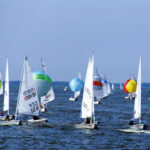The Fiesta Patronales Holiday is celebrated on August 6 as a national holiday in El Salvador. This day is dedicated to the Divine Saviour of the World, Jesus Christ, after whom El Salvador is named. It is accompanied by two days of regional holidays in San Salvador. However, the majority of the festivities and activities take place in San Salvador, the nation’s capital, schools, institutions, and public offices across the country are shut down during this period.
People in the nation’s capital can enjoy processions, floats, music shows, and religious events from August 1 to 6. During this week, the city of San Salvador also sets up a large fairground amusement area with various contests, food, and activities for people to enjoy.
History of Fiesta Patronales Holiday
When Christopher Columbus first set sail for the New World, he gave the islands and coastlines he came across names. He usually chose a saint whose feast day fell on the day of ‘discovery’ (St. Lucia, St. Vincent, etc.). He might have been recovering from a Saturday night when he arrived on a new island on a Sunday morning and named it Dominica (Spanish for ‘Sunday’).
When Pedro de Alvarado, a Conquistador, resolved to name the region he had conquered in the name of Spain, he named it after Jesus Christ. The Province of our Lord Jesus Christ, the Saviour of the World (Provincia De Nuestro Señor Jesus Cristo, El Salvador Del Mundo), was the full name he chose, which was quickly shortened to El Salvador (The Saviour). The capital was named San Salvador (in English, Holy ‘Saviour’).
Returning to the present, Fiesta Patronales is celebrated as both a religious and a patriotic holiday. Two days of municipal holidays are held in San Salvador, also known as Fiestas Agostinas (August Feasts), before the entire country joins in on August 6 for the Celebración del Divino Salvador del Mundo (Celebration of the Divine Saviour of the World).
The “descent” (La Bajada), in which a large parade carrying a purple-dressed wooden statue of Jesus parades through the streets of San Salvador before arriving in front of the Metropolitan Cathedral, is a highlight. The statue then enters a globe (or occasionally a chalice) before emerging covered in white garments, symbolizing the Transfiguration.
Fiesta Patronales Holiday timeline
The Spanish Empire conquers the territory and incorporates it into the Viceroyalty of New Spain.
Under the First Mexican Empire, El Salvador gains independence from Spain.
El Salvador forms a union with Nicaragua and Honduras called the Greater Republic of Central America.
The devastating Salvadoran Civil War erupts between the military-led regime and a section of left-wing guerrilla groups.
A mediated compromise establishes a multiparty constitutional republic, which still exists today.
Fiesta Patronales Holiday FAQs
Why is El Salvador Mundo important?
El Salvador’s Monumento al Divino Salvador del Mundo is a well-known symbol and one of the country’s most recognizable sights. The large memorial was dedicated to Jesus Christ, El Salvador’s patron, in 1942. The monument stands in the Savior of the World Plaza, located near downtown San Salvador.
What is the traditional food in El Salvador?
El Salvador’s national dish is a thick, stuffed corn tortilla cooked in a skillet, traditionally served with tomato salsa and coleslaw. Pupusas are mostly made and eaten by hand. It is sold on numerous street corners throughout the country.
Does El Salvador have independence day?
On September 15, 1821, El Salvador celebrated its independence.
How to Observe Fiesta Patronales Holiday
Attend the festival
The celebrations begin in San Salvador with El Correo, a colorful parade of dancers and entertainers. The statue of Divino Salvador is carried along the city streets to the cathedral, which is the highlight of the festivities.
Visit El Salvador on holiday
El Salvador is among Central America's smallest nations, but it's also one of its most charming countries. El Salvador is rich in natural beauty, beaches, volcanoes, and Maya ruins despite being less popular than its neighbors.
Renew your faith
This could also be an excellent opportunity to renew your faith. Attend a church service or stream one online to take part in the Fiesta Patronales celebrations.
5 Interesting Facts About El Salvador
Land of Volcanoes
El Salvador is called the "land of volcanoes" because it has numerous volcanoes.
Volcanic flag
Five volcanoes represent the five states of the United Provinces of Central America in the coat of arms in the center of the flag.
National bird
El Salvador's national bird is the lovely ‘Torogoz.’
Surfer’s paradise
El Salvador hosts some of the Pacific Ocean's largest swells.
Oldest capital
San Salvador is El Salvador's capital city, and it is Central America's oldest capital city.
Why Fiesta Patronales Holiday is Important
Celebrating the Patron Saint
El Salvador is named after the Divine Saviour of the World, Jesus Christ, who is commemorated on this day. Celebrations are both religious and patriotic.
El Salvador boasts outstanding beauty
El Salvador has numerous volcanoes, many of which remain active, about 186 miles of the Pacific coastline, and over 10 lakes. It is without a doubt a beautiful place to visit.
El Salvador is a surfer’s dream
Not only can you surf without a wetsuit all year in El Salvador due to the warm water, but you can also relish the impressive length of its waves, which can rise to 328 to 656 feet.
Fiesta Patronales Holiday dates
| Year | Date | Day |
|---|---|---|
| 2025 | August 6 | Wednesday |
| 2026 | August 6 | Thursday |
| 2027 | August 6 | Friday |
| 2028 | August 6 | Sunday |
| 2029 | August 6 | Monday |
















